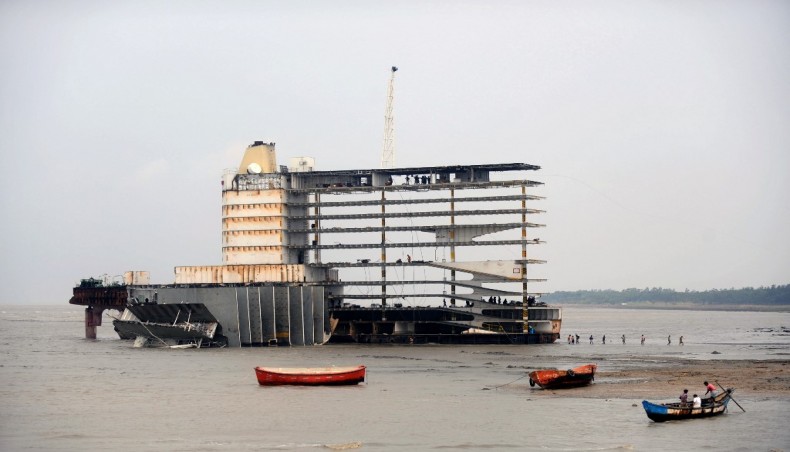
— Dissident Voice/Memory-alpha
ELON Musk and his company SpaceX have become a regular feature in news cycles. SpaceX succeeded in landing a team of astronauts on the International Space Station in November 2020, in partnership with the National Aeronautics and Space Administration. The next month, the company lost a rocket in an explosion while attempting to land after a test flight. Another rocket exploded during landing in early February. In mid-February, SpaceX launched sixty satellites as part of the Starlink programme to provide broadband internet access to the globe, and is now working to double the speed of this internet service and extend it to most of the planet by the end of 2021. Additional crewed missions to the International Space Station are planned for the coming months, as is a four-person civilian-only space voyage.
These accomplishments and setbacks from SpaceX and the world’s richest man are the most recent in a long series of launches by the first private company to engage in spaceflight. SpaceX is pushing many new boundaries to popular acclaim, but they are also simply the most recent continuation of a decades-long effort to privatise space travel, albeit an effort that is accelerating in recent years.
Yet, while SpaceX may be developing beneficial new technologies and finding ways to lower the costs of space travel, their free-market perspective on space exploration will not provide the benefits they claim. Such privatisation will only reproduce the earth’s current exploitative economy and environmental destruction in outer space.
Our climate and economic crises today are not inevitable outcomes of human existence, or of human population growth as other space-obsessed technocrats like Jeff Bezos have argued. They are instead the result of a particular set of social and economic forces, mostly arising during the last five centuries, which constitute capitalism. Capitalism requires the exploitation of both nature and people, leads to outward expansion and colonisation, and is really the root cause of climate change.
Yet instead of working to develop new social and economic structures here on earth, Elon Musk is planning the colonisation of Mars explicitly as a backup plan for earth. He is not alone, as Jeff Bezos’s own aerospace company, Blue Origin, operates with the long-term goal of outsourcing destructive manufacturing to space in order to save earth by shifting the exploitation of nature and people into orbit. With plans such as these, SpaceX and related companies are advocating escapism instead of dealing with the reality of deteriorating conditions on our own planet. By failing to acknowledge that privatising industry and taking advantage of workers and the environment are the true causes of these earthly crises, SpaceX will inadvertently reproduce the same conditions that are destroying the earth in space.
We need not engage in speculation informed by science fiction to know this, either. History is full of examples of privatised, for-profit exploration and colonisation that have caused more harm than good. For some of the clearest lessons, we can look to the colonisation of what is now the United States, just a few hundred years ago.
THIS past autumn marked the four hundredth anniversary of the Mayflower landing on the shores of what is now Massachusetts. Stories of this ship and its pilgrim passengers are familiar to many people who were educated in the American school system. As the common narrative goes, these Puritan settlers sought freedom from religious persecution in England, and thus set sail to the ‘new world.’ The Mayflower arrived in North America, and finding the land beautiful and productive, the pilgrims ‘fell upon their knees and blessed the God of heaven’ for delivering them to safety and freedom.
Yet key details of this story were not emphasised in our elementary school educations, such as the motivations behind the actual owners of the Mayflower. The pilgrims did not own the ship they sailed upon, nor could they have afforded the voyage on their own. They needed investors, and the financial backers of this journey were not religious separatists seeking freedom, but some of the modern world’s first international venture capitalists. They funded the pilgrims in the hope that they could reap the rewards of a profitable colony in North America capable of yielding cheap goods for European markets: largely fish, timber, and furs. The pilgrims who established a colony at Plymouth may have been seeking liberty, but the financiers who backed them hardly cared. They were just in it for the money, and there was a lot to be made.
There was also a lot of damage to be done. Within fifteen years of the Mayflower making landfall, epidemic disease had decimated the indigenous population of New England. Wars and genocide followed, with indigenous peoples being killed and enslaved across the continent, before largely being forced onto reservations which still experience shockingly poor conditions today.
All the while, the land of New England was gradually being divided into privately owned parcels of land in a process known as enclosure. When European colonists arrived in New England, they entered into a variety of agreements with native peoples pertaining to land rights. European settlers often paid indigenous tribes or leaders for the right to limited use of tribal land, but the colonists often interpreted these transactions as wholesale, permanent purchase of land. These lands which were often communally owned by the tribe and managed as a ‘commons’ — land or resources collectively owned by a community — were slowly carved up into privately owned parcels over the course of the 17th and 18th centuries.
This privatisation of land ownership and the incorporation of colonial New England into a globalised market economy led to profound environmental destruction nearly immediately. Settlers cleared forests for timber and farmland, nearly deforesting much of New England by the early 20th century. Beaver and deer were all but exterminated in the region by the 19th century, hunted for their pelts which were sold for profit in European markets. As early as 1646, Portsmouth, Rhode Island established the first prohibitions on hunting deer out of season, recognising that the species’ population was dwindling. All of this local extirpation and deforestation occurred within a few decades of European arrival in New England, while the indigenous peoples of the region had hunted deer and beaver and managed their forests sustainably for millennia prior.
Exploitation of labour arose alongside this exploitation of nature. European settlers in 17th century New England exploited indigenous hunters to acquire beaver furs, obtaining these pelts at little cost to themselves through the exchange of cheap cloth, metal trinkets, and shell beads. Merchants then in turn exploited these European settlers, paying only a small fraction of what these furs would be worth, and manufacturers back in Europe exploited their workers, paying them less than their labour was worth to produce products like fashionable felt hats for sale to the high-society aristocrats of the time.
This exploitation of nature and labour is not a bug, but a feature of privatised, for-profit capitalist ventures. It is inherent in a capitalist economic model, as history has shown time and again. If profit maximisation for the benefit of investors and owners is the goal, as it was for the owners of the Mayflower and as it is for SpaceX, the necessary materials and labour must be cheaply obtained. If they are not cheap, earnings will suffer.
Colonisation is a short-sighted solution to this problem. Colonialist companies and nations incorporate peripheral locations into their global economic system, where resources and labour can be cheaply obtained. The mercantile capitalism of the 17th century Atlantic world reflected this economic structure, with abundant timber, furs, and fish being obtained at low costs in New England and returned to European markets where they had greater value. Whether in the form of colonialist extraction of raw materials or the contemporary outsourcing of jobs, this search for cheap labour and resources is necessary for the perpetuation of capitalism, and remains the structuring force behind the global economy to this day.
This same outward expansion in search of cheap raw materials and labour is exactly what will end up driving the colonisation of space. The moon, Mars, and even asteroids may all become the peripheral, privatised, and exploited locations that permit corporations on earth to profit. Similar to indigenous understandings of certain land rights in pre-colonial New England, space is currently viewed as a global commons. This means that all people have rights to it and none should be able to claim exclusive rights over it. The Outer Space Treaty of 1967 prevents any nation from claiming territory in space, although the treaty is known to be vague concerning the power of corporations in space and will certainly be challenged legally in the coming years. The enclosure and privatisation of space may therefore lead not only to the direct and immediate exploitation of the environment and of people, but may also lay the groundwork for long-term systems of exploitation and dispossession.
ELON Musk intends to colonise Mars as soon as possible. Thankfully, there is no potential for genocide of indigenous Martians as there was for indigenous ‘Americans’ and other indigenous peoples around the world under European colonialism. Yet because the endeavour is privatised and operating under centuries-old colonialist mindsets, exploitation and destruction will assuredly manifest in other ways.
Mining and resource extraction is one avenue for profit, although Musk acknowledges that it is unclear if the natural resources on Mars could be extracted for the profit of companies on earth. Even if the costs of transporting raw materials back to earth are too great, natural resources extracted in space could be manufactured in space and shipped to earth. Colonisation of Mars may therefore differ slightly from cases of colonisation on earth, but the fundamental exploitative relationship remains.
Plus, there are other ways to profit besides the extraction of raw materials. Space tourism by wealthy thrill-seekers is poised to be a cash cow for companies, and a relatively autonomous SpaceX colony on Mars could also have a potentially great degree of freedom to profit from all sorts of business ventures, especially if they are legally independent of the United States government as has been hinted. Musk has also alluded to other ‘extraordinary entrepreneurial opportunity’ on Mars, ranging from manufacturing to restaurants to tourism. However, it remains to be seen just how the financing, ownership, and taxation of these enterprises will be handled in what may be a semi-autonomous colony. In the case of English colonists arriving in North America, it was often the case that the company financing the colony claimed ownership over all property and all economic products of the settlers for a set number of years. Any colonists on a settled Mars will certainly be exploited as well, in one form or another, for the profit of shareholders and company executives. More than a colony of earth, Mars may become a colony of SpaceX, and this is a troubling thought.
Resisting exploitation is exceedingly difficult in a privately funded, owned, and operated colony because such a colony is, by its very nature, undemocratic. Private companies like SpaceX are not democracies. Chief executive officers are not elected representatives of the employees and business decisions are not voted upon by all workers. Thus, with a corporation calling the shots, settlers on Mars may have disturbingly little input in decision-making processes concerning their businesses and lives.
Fundamentally, the privatisation of space exploration is not the beneficial solution that many think it is. It will simply result in a continuation of the colonial exploitation of nature and people as our capitalist global economy transcends our own atmosphere. Exploitation is an inherent part of such for-profit ventures in a capitalist system, and this will carry over into space. Privatised exploration of our solar system will be biased towards profitable ventures instead of those with public benefits and will certainly have numerous detrimental environmental impacts.
As private corporations begin to stake claims and enclose the commons of space, the rest of us lose our rights to it. We must avoid this outcome at all costs. Studying the repercussions of historical and contemporary colonialism on earth permits us to engage with questions of space exploration from a decolonial and democratic perspective. Space cannot be privatised or exploited for profit, but must remain a commons for the benefit of all humanity.
DissidentVoice.org, March 9. Elic M Weitzel is a human ecologist, anthropologist and archaeologist interested in understanding humans in their environmental and social contexts. He is affiliated with the department of anthropology at the University of Connecticut.












